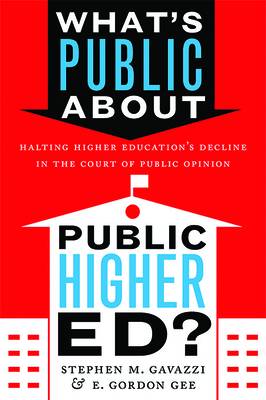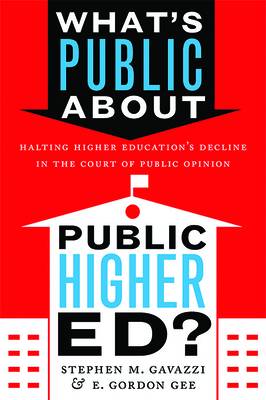
- Retrait gratuit dans votre magasin Club
- 7.000.000 titres dans notre catalogue
- Payer en toute sécurité
- Toujours un magasin près de chez vous
- Retrait gratuit dans votre magasin Club
- 7.000.000 titres dans notre catalogue
- Payer en toute sécurité
- Toujours un magasin près de chez vous
What's Public about Public Higher Ed?
Halting Higher Education's Decline in the Court of Public Opinion
Stephen M Gavazzi, E Gordon GeeDescription
Exploring the current state of relationships between public universities, government leaders, and the citizens who elect them, this book offers insight into how to repair the growing rift between higher education and its public.
Higher education gets a bad rap these days. The public perception is that there is a growing rift between public universities and the elected officials who support them. In What's Public about Public Higher Ed?, Stephen M. Gavazzi and E. Gordon Gee explore the reality of that supposed divide, offering qualitative and quantitative evidence of why it's happened and what can be done about it.
Critical problems, Gavazzi and Gee argue, have arisen because higher education leaders often assumed that what was good for universities was good for the public at large. For example, many public institutions have placed more emphasis on research at the expense of teaching, learning, and outreach. This university-centric viewpoint has contributed significantly to the disconnect between our nation's public universities and the representatives of the people they are supposed to be serving. But this gulf can only be bridged, the authors insist, if people at the universities take the time to really listen to what the citizens of their states are asking of them.
Gavazzi and Gee draw on never-before-gathered survey data on public sentiment regarding higher education. Collected from citizens residing in the four most populous states--California, Florida, New York, and Texas--plus Ohio and West Virginia, the authors' home states, this data reflects critical issues, including how universities spend taxpayer money, the pursuit of national rankings, student financial aid, and the interplay of international activities versus efforts to create "closer to home" impact. An unflinching, no-holds-barred exploration of what citizens really think about their public universities, What's Public about Public Higher Ed? also places special emphasis on the events of 2020--including the COVID-19 pandemic and the worst racial unrest seen in half a century--as major inflection points for understanding the implications of the survey's findings.
Spécifications
Parties prenantes
- Auteur(s) :
- Editeur:
Contenu
- Nombre de pages :
- 232
- Langue:
- Anglais
Caractéristiques
- EAN:
- 9781421442525
- Date de parution :
- 19-10-21
- Format:
- Livre relié
- Format numérique:
- Genaaid
- Dimensions :
- 148 mm x 230 mm
- Poids :
- 453 g







